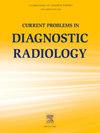Breast Imaging: what women & healthcare professionals need to know
IF 1.5
Q3 RADIOLOGY, NUCLEAR MEDICINE & MEDICAL IMAGING
引用次数: 0
Abstract
Women in Radiology should be aware of the importance of early detection of breast cancer, the most common cancer in women. This knowledge is essential to advocate for high quality breast imaging for women, including themselves and their patients. The imaging modalities used in breast imaging have dramatically changed the way in which breast cancer may be diagnosed, and their use affects the stage at which it is diagnosed. Breast cancer may be screen-detected, either with mammography, digital breast tomosynthesis, breast ultrasound, breast MRI or contrast-enhanced mammography, and is typically diagnosed at stage 1. Incidental detection with Chest CT, abdominal CT or MRI or by PET CT may also lead to a diagnosis of breast cancer. When detected because of symptoms in women who have not undergone routine screening or as an interval cancer in women after a normal screen typically because of the masking effect of dense breast tissue, breast cancer is typically diagnosed at a more advanced stage, stage IIA or greater. A review of the imaging modalities currently used to diagnose breast cancer is provided and includes the advantages and limitations of each modality and the ways to optimize the imaging quality for detection of breast cancer. Up-to-date recommendations aimed to minimize the harms of delayed diagnosis of breast cancer are summarized to improve the health of women in Radiology and their patients.
乳房成像:女性和医疗保健专业人员须知
放射科的女性应了解早期发现乳腺癌(女性最常见的癌症)的重要性。这些知识对于倡导为妇女(包括她们自己和她们的病人)提供高质量的乳腺成像至关重要。乳腺成像中使用的成像模式极大地改变了乳腺癌的诊断方式,其使用会影响乳腺癌的诊断阶段。乳腺癌可通过乳房 X 线照相术、数字乳腺断层扫描、乳腺超声波、乳腺核磁共振成像或造影剂增强乳腺 X 线照相术进行筛查发现,通常诊断为第一期。胸部 CT、腹部 CT 或 MRI 或正电子发射计算机断层扫描(PET CT)的偶然发现也可能导致乳腺癌的诊断。如果未接受常规筛查的妇女因症状而被发现,或在筛查正常后因致密乳腺组织的掩盖作用而被发现为间期癌,乳腺癌的诊断通常处于较晚期阶段,即 IIA 期或更高阶段。本文回顾了目前用于诊断乳腺癌的成像模式,包括每种模式的优势和局限性,以及优化成像质量以检测乳腺癌的方法。总结了旨在将乳腺癌延迟诊断的危害降至最低的最新建议,以改善放射科妇女及其患者的健康。
本文章由计算机程序翻译,如有差异,请以英文原文为准。
求助全文
约1分钟内获得全文
求助全文
来源期刊

Current Problems in Diagnostic Radiology
RADIOLOGY, NUCLEAR MEDICINE & MEDICAL IMAGING-
CiteScore
3.00
自引率
0.00%
发文量
113
审稿时长
46 days
期刊介绍:
Current Problems in Diagnostic Radiology covers important and controversial topics in radiology. Each issue presents important viewpoints from leading radiologists. High-quality reproductions of radiographs, CT scans, MR images, and sonograms clearly depict what is being described in each article. Also included are valuable updates relevant to other areas of practice, such as medical-legal issues or archiving systems. With new multi-topic format and image-intensive style, Current Problems in Diagnostic Radiology offers an outstanding, time-saving investigation into current topics most relevant to radiologists.
 求助内容:
求助内容: 应助结果提醒方式:
应助结果提醒方式:


